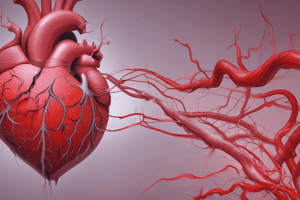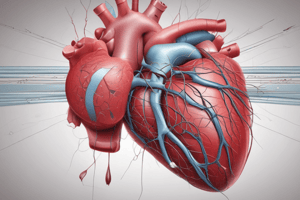Podcast
Questions and Answers
S/sx of myocarditis include fever, fatigue, chest pain, and ______.
S/sx of myocarditis include fever, fatigue, chest pain, and ______.
SOB
Endocarditis can be caused by infections such as ______ or Staphylococcus.
Endocarditis can be caused by infections such as ______ or Staphylococcus.
TB
In Peripheral Arterial Disease (PAD), the buildup of plaque affects the ______ extremities.
In Peripheral Arterial Disease (PAD), the buildup of plaque affects the ______ extremities.
lower
Patients with coronary artery disease (CAD) may experience ______ pain.
Patients with coronary artery disease (CAD) may experience ______ pain.
The presence of fat embolism is often indicated by a 'snow storm' appearance on ______.
The presence of fat embolism is often indicated by a 'snow storm' appearance on ______.
Virchow's Triad includes stasis of venous circulation, hypercoagulability, and ______ damage.
Virchow's Triad includes stasis of venous circulation, hypercoagulability, and ______ damage.
The normal BNP level is less than ______ pg/mL; levels above indicate heart failure.
The normal BNP level is less than ______ pg/mL; levels above indicate heart failure.
Patients with mechanical valves require lifelong ______ therapy to prevent thromboembolism.
Patients with mechanical valves require lifelong ______ therapy to prevent thromboembolism.
In myocarditis, the inflammation typically occurs due to a viral ______.
In myocarditis, the inflammation typically occurs due to a viral ______.
Scleroderma is associated with abnormal blood flow in response to ______.
Scleroderma is associated with abnormal blood flow in response to ______.
Blood flow follows the order: Tricuspid → Pulmonic → Mitral → ______
Blood flow follows the order: Tricuspid → Pulmonic → Mitral → ______
The acronym APE To Man helps to remember the heart sounds associated with the ______ valve.
The acronym APE To Man helps to remember the heart sounds associated with the ______ valve.
In Acute Coronary Syndromes, NSTEMI is caused by a ______ occlusion that leads to ischemia.
In Acute Coronary Syndromes, NSTEMI is caused by a ______ occlusion that leads to ischemia.
Prinzmetal's Angina is typically triggered by ______ stress, cold weather, and smoking.
Prinzmetal's Angina is typically triggered by ______ stress, cold weather, and smoking.
The acronym MONA refers to the medications administered during a ______.
The acronym MONA refers to the medications administered during a ______.
Left-sided heart failure can lead to ______ edema, dyspnea, and orthopnea.
Left-sided heart failure can lead to ______ edema, dyspnea, and orthopnea.
Cardiac Tamponade is a medical emergency characterized by fluid buildup in the ______.
Cardiac Tamponade is a medical emergency characterized by fluid buildup in the ______.
Women may experience atypical symptoms such as neck, shoulder, or jaw pain during a ______.
Women may experience atypical symptoms such as neck, shoulder, or jaw pain during a ______.
The presence of a friction rub is an indicator of ______.
The presence of a friction rub is an indicator of ______.
In right-sided heart failure, signs include peripheral ______, weight gain, and JVD.
In right-sided heart failure, signs include peripheral ______, weight gain, and JVD.
Flashcards
Blood Flow Pathway
Blood Flow Pathway
The sequence of blood flow through the heart's valves: Tricuspid → Pulmonic → Mitral → Aortic
Myocarditis
Myocarditis
Inflammation of the heart muscle, often caused by viruses.
Heart Sound Location
Heart Sound Location
A mnemonic to locate heart sounds: Aortic, Pulmonary, Erb's Point, Tricuspid, Mitral.
Endocarditis
Endocarditis
Signup and view all the flashcards
Unstable Angina
Unstable Angina
Signup and view all the flashcards
Peripheral Arterial Disease (PAD)
Peripheral Arterial Disease (PAD)
Signup and view all the flashcards
Coronary Artery Disease (CAD)
Coronary Artery Disease (CAD)
Signup and view all the flashcards
NSTEMI
NSTEMI
Signup and view all the flashcards
STEMI
STEMI
Signup and view all the flashcards
Deep Vein Thrombosis (DVT)
Deep Vein Thrombosis (DVT)
Signup and view all the flashcards
Virchow's Triad
Virchow's Triad
Signup and view all the flashcards
Angina
Angina
Signup and view all the flashcards
Pleuritic Chest Pain
Pleuritic Chest Pain
Signup and view all the flashcards
Myocardial Infarction (MI)
Myocardial Infarction (MI)
Signup and view all the flashcards
Fat Embolism
Fat Embolism
Signup and view all the flashcards
Right-sided Heart Failure (Cor Pulmonale)
Right-sided Heart Failure (Cor Pulmonale)
Signup and view all the flashcards
Left-sided Heart Failure
Left-sided Heart Failure
Signup and view all the flashcards
Scleroderma
Scleroderma
Signup and view all the flashcards
BNP
BNP
Signup and view all the flashcards
Cardiac Tamponade
Cardiac Tamponade
Signup and view all the flashcards
Study Notes
Cardiovascular System
- Blood Flow: Tricuspid → Pulmonic → Mitral → Aortic (APE To Man)
- Acute Coronary Syndromes:
- Unstable Angina: Minor occlusion, pain typically relieved by medication.
- NSTEMI: Partial occlusion, ischemia and heart muscle damage, requires PCI or thrombolytics.
- STEMI: Full occlusion, infarction or death of heart muscle, labs show elevated biomarkers, ST elevation on EKG, requires PCI.
- Angina: Chest pain due to reduced blood flow to the heart. Treat with rest, vital signs, ECG for active angina. <5 minutes between nitroglycerin tablets if no relief contact emergency personnel.
- Myocardial Infarction (MI): Blockage of blood flow to the heart, severe chest pain/pressure, dyspnea, diaphoresis, Women: neck, shoulder, jaw pain, fatigue, SOB, vomiting,heartburn. Give MONA (Morphine, Oxygen, Nitroglycerin, Aspirin). Test for Myoglobin, CK, and Troponin.
- Heart Failure: Heart is unable to meet body's oxygen demands, blood backs up in the body (right sided) or lungs (left sided). Needs O2, diuretics, monitor vital signs and I&O's, assess for hypoxia and edema, daily weights, and fluid/sodium restriction.
- Right-sided HF/Cor Pulmonale: Caused by left ventricular failure, s/sx are peripheral edema, JVD, weight gain, hepatomegaly.
- Left-sided HF: S/sx: pulmonary edema, dyspnea, orthopnea, crackles, cough.
Additional Cardiovascular Conditions
- Cardiac Tamponade: Fluid buildup in the pericardium, creates pressure, medical emergency, Beck's Triad (hypotension, JVD, muffled heart sounds), pericardiocentesis needed.
- Pericarditis: Inflammation of the outer layer of the heart, friction rub, pain, ECG changes. Management: NSAIDs, corticosteroids, monitor for tamponade.
- Myocarditis: Inflammation of the myocardium, typically viral infection. S/sx: fever, fatigue, chest pain, SOB. Treat symptoms, O2 as needed, bed rest, diuretics, ACEi, sodium restriction (if heart failure develops).
- Endocarditis: Inflammation of inner lining of the heart, infections like TB or Staph, autoimmune conditions. S/sx: SOB, fever, palpitations, night sweats. Treatment IV antibiotics, monitor for emboli .
- Peripheral Arterial Disease (PAD): Chronic atherosclerotic disease, affects lower extremities, common causes tissue necrosis. Treatment: lower extremities below heart, moderate exercise, daily skin care, meds, warmth, and caution about tight clothing.
- Coronary Artery Disease (CAD): Plaque buildup in coronary arteries limits blood flow, s/sx: angina, fatigue, SOB, heart attack. Treatment: control BP, low-fat/low-salt diet, stop smoking, regular exercise. Encourage healthy lifestyle changes.
- Scleroderma: Causes abnormal blood flow, especially in response to cold.
- Fat Embolism: Usually after fractures of long bones. S/sx: SOB, confusion, tachycardia, lethargy.
- Deep Vein Thrombosis (DVT): Thrombus forms in vein, usually legs; s/sx: warm skin, calf pain, edema. Treatment: bed rest, elevate extremity, compression stockings, anticoagulants, thrombolytics.
Additional Notes
- Improve perfusion: Elevate veins, dangle arteries.
- Hypertension: Assess BP in both arms.
- Mechanical Valves: Anticoagulation therapy needed to prevent thromboembolism.
- Fluid Retention: Heart issue is likely first consideration.
- BNP: >100 pg/mL indicates heart failure.
Studying That Suits You
Use AI to generate personalized quizzes and flashcards to suit your learning preferences.




